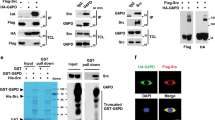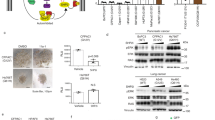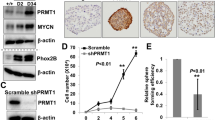Abstract
Lithium has long been used for the treatment and prophylaxis of bipolar mood disorder. However, nerve cells are not the sole targets of lithium. Indeed, lithium was reported to target numerous cell types, and affect cell proliferation, differentiation and death. Thus, the idea has been raised that lithium may act on signaling pathways involved in neoplastic transformation. Indeed, the effect of lithium on tumor progression is currently being tested in a limited number of clinical trials. However, the molecular mechanisms by which lithium affects neoplastic transformation remain to be characterized. Here, using mouse fibroblasts transformed by the v-src oncogene as a model, we show that lithium drastically inhibits cell motility and compromises the invasive phenotype of v-src-transformed cells. In addition, we show that this effect is mediated by the activation of phosphotyrosine phosphatases, but not by the direct inhibition of the v-Src tyrosine kinase. Finally, we show that lithium activates phosphotyrosine phosphatases by the modulation of the redox status of the cell, independently of the Wnt and the inositol phosphate canonical pathways. Thus, this study supports the idea that lithium, acting similar to an antioxydizer, may have antimetastatic properties in vivo.
This is a preview of subscription content, access via your institution
Access options
Subscribe to this journal
Receive 50 print issues and online access
$259.00 per year
only $5.18 per issue
Buy this article
- Purchase on Springer Link
- Instant access to full article PDF
Prices may be subject to local taxes which are calculated during checkout











Similar content being viewed by others
References
Aghdam SY, Barger SW . (2007). Glycogen synthase kinase-3 in neurodegeneration and neuroprotection: lessons from lithium. Curr Alzheimer Res 4: 21–31.
Almeida CG, de Mendonca A, Cunha RA, Ribeiro JA . (2003). Adenosine promotes neuronal recovery from reactive oxygen species induced lesion in rat hippocampal slices. Neurosci Lett 339: 127–130.
Almeida M, Han L, Bellido T, Manolagas SC, Kousteni S . (2005). Wnt proteins prevent apoptosis of both uncommitted osteoblast progenitors and differentiated osteoblasts by beta-catenin-dependent and -independent signaling cascades involving Src/ERK and phosphatidylinositol 3-kinase/AKT. J Biol Chem 280: 41342–41351.
Aouacheria A, Ory S, Schmitt JR, Rigal D, Jurdic P, Gillet G . (2002). p60(v-src) and serum control cell shape and apoptosis via distinct pathways in quail neuroretina cells. Oncogene 21: 1171–1186.
Beaulieu JM, Marion S, Rodriguiz RM, Medvedev IO, Sotnikova TD, Ghisi V et al. (2008). A beta-arrestin 2 signaling complex mediates lithium action on behavior. Cell 132: 125–136.
Benati D, Baldari CT . (2008). SRC family kinases as potential therapeutic targets for malignancies and immunological disorders. Curr Med Chem 15: 1154–1165.
Cartwright CA, Meisler AI, Eckhart W . (1990). Activation of the pp60c-src protein kinase is an early event in colonic carcinogenesis. Proc Natl Acad Sci USA 87: 558–562.
Clement-Lacroix P, Ai M, Morvan F, Roman-Roman S, Vayssiere B, Belleville C et al. (2005). Lrp5-independent activation of Wnt signaling by lithium chloride increases bone formation and bone mass in mice. Proc Natl Acad Sci USA 102: 17406–17411.
Cross FR, Hanafusa H . (1983). Local mutagenesis of Rous sarcoma virus: the major sites of tyrosine and serine phosphorylation of pp60src are dispensable for transformation. Cell 34: 597–607.
Cui J, Shao L, Young LT, Wang JF . (2007). Role of glutathione in neuroprotective effects of mood stabilizing drugs lithium and valproate. Neuroscience 144: 1447–1453.
D’Alessio M, Cerella C, Amici C, Pesce C, Coppola S, Fanelli C et al. (2004). Glutathione depletion up-regulates Bcl-2 in BSO-resistant cells. FASEB J 18: 1609–1611.
Edwards CM, Edwards JR, Lwin ST, Esparza J, Oyajobi BO, McCluskey B et al. (2008). Increasing Wnt signaling in the bone marrow microenvironment inhibits the development of myeloma bone disease and reduces tumor burden in bone in vivo. Blood 111: 2833–2842.
Gillet G, Michel D, Crisanti P, Guerin M, Herault Y, Pessac B et al. (1993). Serum factors and v-src control two complementary mitogenic pathways in quail neuroretinal cells in culture. Oncogene 8: 565–574.
Gould TD, Manji HK . (2005). Glycogen synthase kinase-3: a putative molecular target for lithium mimetic drugs. Neuropsychopharmacology 30: 1223–1237.
Gould TD, Quiroz JA, Singh J, Zarate CA, Manji HK . (2004). Emerging experimental therapeutics for bipolar disorder: insights from the molecular and cellular actions of current mood stabilizers. Mol Psychiatry 9: 734–755.
Hashimoto R, Fujimaki K, Jeong MR, Christ L, Chuang DM . (2003). Lithium-induced inhibition of Src tyrosine kinase in rat cerebral cortical neurons: a role in neuroprotection against N-methyl-D-aspartate receptor-mediated excitotoxicity. FEBS Lett 538: 145–148.
Ingley E . (2008). Src family kinases: regulation of their activities, levels and identification of new pathways. Biochim Biophys Acta 1784: 56–65.
Johnson FM, Gallick GE . (2007). SRC family nonreceptor tyrosine kinases as molecular targets for cancer therapy. Anticancer Agents Med Chem 7: 651–659.
Jove R, Mayer BJ, Iba H, Laugier D, Poirier F, Calothy G et al. (1986). Genetic analysis of p60v-src domains involved in the induction of different cell transformation parameters. J Virol 60: 840–848.
Kao KR, Elinson RP . (1989). Dorsalization of mesoderm induction by lithium. Dev Biol 132: 81–90.
Karlovic D, Jakopec S, Dubravcic K, Batinic D, Buljan D, Osmak M . (2007). Lithium increases expression of p21(WAF/Cip1) and survivin in human glioblastoma cells. Cell Biol Toxicol 23: 83–90.
Kmiecik TE, Johnson PJ, Shalloway D . (1988). Regulation by the autophosphorylation site in overexpressed pp60c-src. Mol Cell Biol 8: 4541–4546.
Linder S, Kopp P . (2005). Podosomes at a glance. J Cell Sci 118: 2079–2082.
Mao CD, Hoang P, DiCorleto PE . (2001). Lithium inhibits cell cycle progression and induces stabilization of p53 in bovine aortic endothelial cells. J Biol Chem 276: 26180–26188.
Markova B, Gulati P, Herrlich PA, Bohmer FD . (2005). Investigation of protein-tyrosine phosphatases by in-gel assays. Methods 35: 22–27.
Maroney AC, Qureshi SA, Foster DA, Brugge JS . (1992). Cloning and characterization of a thermolabile v-src gene for use in reversible transformation of mammalian cells. Oncogene 7: 1207–1214.
Mathew S, George SP, Wang Y, Siddiqui MR, Srinivasan K, Tan L et al. (2008). Potential molecular mechanism for c-Src kinase-mediated regulation of intestinal cell migration. J Biol Chem 283: 22709–22722.
Moldovan L, Moldovan NI, Sohn RH, Parikh SA, Goldschmidt-Clermont PJ . (2000). Redox changes of cultured endothelial cells and actin dynamics. Circ Res 86: 549–557.
Moldovan L, Mythreye K, Goldschmidt-Clermont PJ, Satterwhite LL . (2006). Reactive oxygen species in vascular endothelial cell motility. Roles of NAD(P)H oxidase and Rac1. Cardiovasc Res 71: 236–246.
Ohteki T, Parsons M, Zakarian A, Jones RG, Nguyen LT, Woodgett JR et al. (2000). Negative regulation of T cell proliferation and interleukin 2 production by the serine threonine kinase GSK-3. J Exp Med 192: 99–104.
Oikawa T, Itoh T, Takenawa T . (2008). Sequential signals toward podosome formation in NIH-src cells. J Cell Biol 182: 157–169.
Pao LI, Badour K, Siminovitch KA, Neel BG . (2007). Nonreceptor protein-tyrosine phosphatases in immune cell signaling. Annu Rev Immunol 25: 473–523.
Park CH, Chang JY, Hahm ER, Park S, Kim HK, Yang CH . (2005). Quercetin, a potent inhibitor against beta-catenin/Tcf signaling in SW480 colon cancer cells. Biochem Biophys Res Commun 328: 227–234.
Pessac B, Calothy G . (1974). Transformation of chick embryo neuroretinal cells by Rous sarcoma virus in vitro: induction of cell proliferation. Science 185: 709–710.
Pizarro JG, Folch J, Esparza JL, Jordan J, Pallas M, Camins A . (2008). A molecular study of pathways involved in the inhibition of cell proliferation in neuroblastoma B65 cells by the GSK-3 inhibitors lithium and SB-415286. J Cell Mol Med (e-pub ahead of print 20 June).
Reya T, Clevers H . (2005). Wnt signalling in stem cells and cancer. Nature 434: 843–850.
Ronziere MC, Roche S, Gouttenoire J, Demarteau O, Herbage D, Freyria AM . (2003). Ascorbate modulation of bovine chondrocyte growth, matrix protein gene expression and synthesis in three-dimensional collagen sponges. Biomaterials 24: 851–861.
Roskoski Jr R . (2004). Src protein-tyrosine kinase structure and regulation. Biochem Biophys Res Commun 324: 1155–1164.
Sarkar S, Floto RA, Berger Z, Imarisio S, Cordenier A, Pasco M et al. (2005). Lithium induces autophagy by inhibiting inositol monophosphatase. J Cell Biol 170: 1101–1111.
Schindler T, Sicheri F, Pico A, Gazit A, Levitzki A, Kuriyan J . (1999). Crystal structure of Hck in complex with a Src family-selective tyrosine kinase inhibitor. Mol Cell 3: 639–648.
Seelan RS, Khalyfa A, Lakshmanan J, Casanova MF, Parthasarathy RN . (2008). Deciphering the lithium transcriptome: microarray profiling of lithium-modulated gene expression in human neuronal cells. Neuroscience 151: 1184–1197.
Severus WE, Kleindienst N, Seemuller F, Frangou S, Moller HJ, Greil W . (2008). What is the optimal serum lithium level in the long-term treatment of bipolar disorder—a review? Bipolar Disord 10: 231–237.
Smits VA, Essers MA, Loomans DS, Klompmaker R, Rijksen G, Medema RH . (1999). Inhibition of cell proliferation by lithium is associated with interference in cdc2 activation. FEBS Lett 457: 23–27.
Song L, Zhou T, Jope RS . (2004). Lithium facilitates apoptotic signaling induced by activation of the Fas death domain-containing receptor. BMC Neurosci 5: 20.
Stump RJ, Lovicu FJ, Ang SL, Pandey SK, McAvoy JW . (2006). Lithium stabilizes the polarized lens epithelial phenotype and inhibits proliferation, migration, and epithelial mesenchymal transition. J Pathol 210: 249–257.
Sun A, Shanmugam I, Song J, Terranova PF, Thrasher JB, Li B . (2007). Lithium suppresses cell proliferation by interrupting E2F-DNA interaction and subsequently reducing S-phase gene expression in prostate cancer. Prostate 67: 976–988.
Van Lookeren Campagne MM, Wang M, Spek W, Peters D, Schaap P . (1988). Lithium respecifies cyclic AMP-induced cell-type specific gene expression in Dictyostelium. Dev Genet 9: 589–596.
Wada A, Yokoo H, Yanagita T, Kobayashi H . (2005). Lithium: potential therapeutics against acute brain injuries and chronic neurodegenerative diseases. J Pharmacol Sci 99: 307–321.
Welshons WV, Engler KS, Taylor JA, Grady LH, Curran EM . (1995). Lithium-stimulated proliferation and alteration of phosphoinositide metabolites in MCF-7 human breast cancer cells. J Cell Physiol 165: 134–144.
Yang B, Keshelava N, Anderson CP, Reynolds CP . (2003). Antagonism of buthionine sulfoximine cytotoxicity for human neuroblastoma cell lines by hypoxia is reversed by the bioreductive agent tirapazamine. Cancer Res 63: 1520–1526.
Zhang WV, Jullig M, Connolly AR, Stott NS . (2005). Early gene response in lithium chloride induced apoptosis. Apoptosis 10: 75–90.
Zhen X, Torres C, Friedman E . (2002). Lithium regulates protein tyrosine phosphatase activity in vitro and in vivo. Psychopharmacology (Berl) 162: 379–384.
Acknowledgements
We thank Pierre Jurdic and Philippe Gonzalo for helpfull discussions and critical reading of the paper. We acknowledge Aurélie Cornut for skillfull technical assistance. This work was supported by the Association pour la Recherche sur le Cancer (ARC), the Ligue Nationale contre le Cancer and the Région Rhône Alpes. BDN is a recipient of fellowships from the Ministère de la Recherche and the ARC.
Author information
Authors and Affiliations
Corresponding author
Additional information
Supplementary Information accompanies the paper on the Oncogene website (http://www.nature.com/onc)
Rights and permissions
About this article
Cite this article
Néel, B., Lopez, J., Chabadel, A. et al. Lithium suppresses motility and invasivity of v-src-transformed cells by glutathione-dependent activation of phosphotyrosine phosphatases. Oncogene 28, 3246–3260 (2009). https://doi.org/10.1038/onc.2009.190
Received:
Revised:
Accepted:
Published:
Issue Date:
DOI: https://doi.org/10.1038/onc.2009.190
Keywords
This article is cited by
-
Src tyrosine kinase inhibits apoptosis through the Erk1/2- dependent degradation of the death accelerator Bik
Cell Death & Differentiation (2012)



